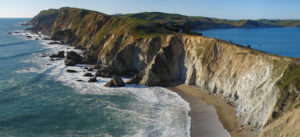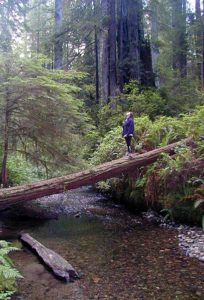One of the joys of writing this calendar is shining a light on people and events that have lived more in the shadows than in the spotlight. Today is the birthday of one such man, called by those who knew him the “20th Century John Muir.” He is Dr. Edgar Wayburn.
Wayburn was born on September 17, 1906 (died at age 103 in 2010) in Georgia. His genial Georgian accent and nature served him well throughout his life. He graduated from the University of Georgia at age 19 and the Harvard Medical School at age 23. He practiced (and taught) medicine for 50 years.
As a boy, he took summer trips annually to San Francisco to visit an uncle. After finishing medical school and a four-year Army tour in Europe during World War II, he moved to there permanently. Two observations determined Wayburn’s avocation for the rest of his life. First, he observed the rapid development of the country after the war and despaired that nature was being pushed beyond the experience of most people. Second, he marveled that Marin County, just north of San Francisco and dominated by scenic hills and valleys, had not yet been developed. He later said, “It seemed incredible to me that there were no cities or suburbs built on those Marin hills so close to San Francisco. I wondered how long that miracle would last.”

Wayburn determined that he would make it last. He had joined the Sierra Club in 1939 so he could take a burro excursion, and he never left. He served on the executive board for 34 years and was president five terms during the 1960s. Wayburn helped convert a California outing club to a national and global conservation powerhouse. He spent a lifetime in quiet, behind-the-scenes advocacy for preserving wild lands. He wrote letters, raised money, participated in public meetings, submitted comments on government proposals and lobbied elected officials.
He was effective without marches, protests or media campaigns. Pat Joseph, writing for the Sierra club, called Wayburn “a born facilitator and diplomat, someone who exuded the kind of authority and integrity that gets people—even powerful people—to listen. Rogers Morton, Secretary of Interior under Richard Nixon and not overly enthusiastic about locking up lands, told a congressional hearing about a park’s borders that “The Park Service wants me to support their plan, but I went out there to the site with my friend Dr. Wayburn, and he convinced me otherwise.”
He convinced a lot of people “otherwise” over the last half of the century. In 1958, he successfully lobbied the state of California to expand Mount Tamalpais State Park near San Francisco from 870 acres to more than 6,000 acres, a seven-fold increase. Next came his successful drives to create Point Reyes National Seashore, just north of San Francisco, and then Golden Gate National Recreation Area, the nation’s (and probably the world’s) largest national park in and adjacent to a major city. He then spurred the establishment of Redwood National Park.

He and his wife, Peggy Elliott, a former Vogue magazine editor, hiked throughout the region—and then into Alaska in the late 1960s. They were once again mesmerized, as he had been by the Marin Headlands, by the grandeur of the place and the opportunity for preservation. Now with a fully developed sense of what was needed, Wayburn had realized that “It wasn’t enough simply to add a few acres here and there; nature doesn’t divide herself into measured plots. A watershed encompasses the chain of life; if any part is developed, the integrity of the whole ecosystem is threatened.”
He went really big this time, proposing a massive set of preserved lands for Alaska. In 1980, his vision came to pass through the Alaska National Interest Lands Conservation Act (ANILCA, for short). ANILCA set aside more than 100 million acres of federal lands as national parks, wildlife refuges and other protected sites. With those additions, the area administered by the National Park Service doubled.
Never a household name, Wayburn did earn recognition as perhaps the most effective conservationist of the last 75 years. Among other awards, President Clinton presented him with the Presidential Medal of Freedom in 1999. When proclaiming the award, Clinton noted that Wayburn had “saved more of our wilderness than any person alive.”
Like Gro Harlem Brundtland, another physician and conservationist, Edgar Wayburn understood that human health and sustainability were not two things, but one. In an interview for the San Francisco Medical Society, he summed up his philosophy:
“I have loved medicine and conservation. In one sense, my involvement with both might be summed up in a single word: survival. Medicine is concerned with the short-term survival of the human species, conservation with the long-term survival of the human and other species as well. We are all related.”
References:
Brown, Emma. 2010. Edgar Wayburn, 103, dies; No 1 protector of U.S. wilderness. Washington Post, March 9, 2010. Available at: http://www.washingtonpost.com/wp-dyn/content/article/2010/03/08/AR2010030805247.html?noredirect=on. Accessed August 2, 2018.
Joseph, Pat. 2010. Dr. Edgar Wayburn, M.D.: 1906-2010. Sierra Club. Available at: http://vault.sierraclub.org/history/wayburn/. Accessed August 2, 2018.
Martin, Douglas. 2010. Edgar Wayburn, a Leader in Saving the Wilderness, Dies at 103. The New York Times, March 10, 2010. Available at: https://www.nytimes.com/2010/03/10/us/10wayburn.html. Accessed August 2, 2018.
